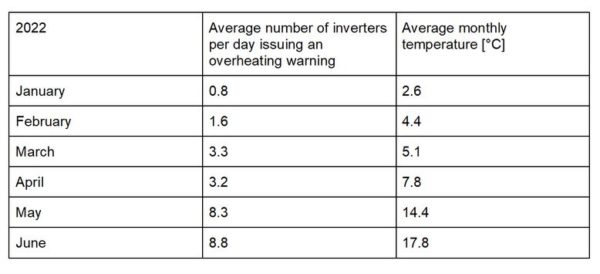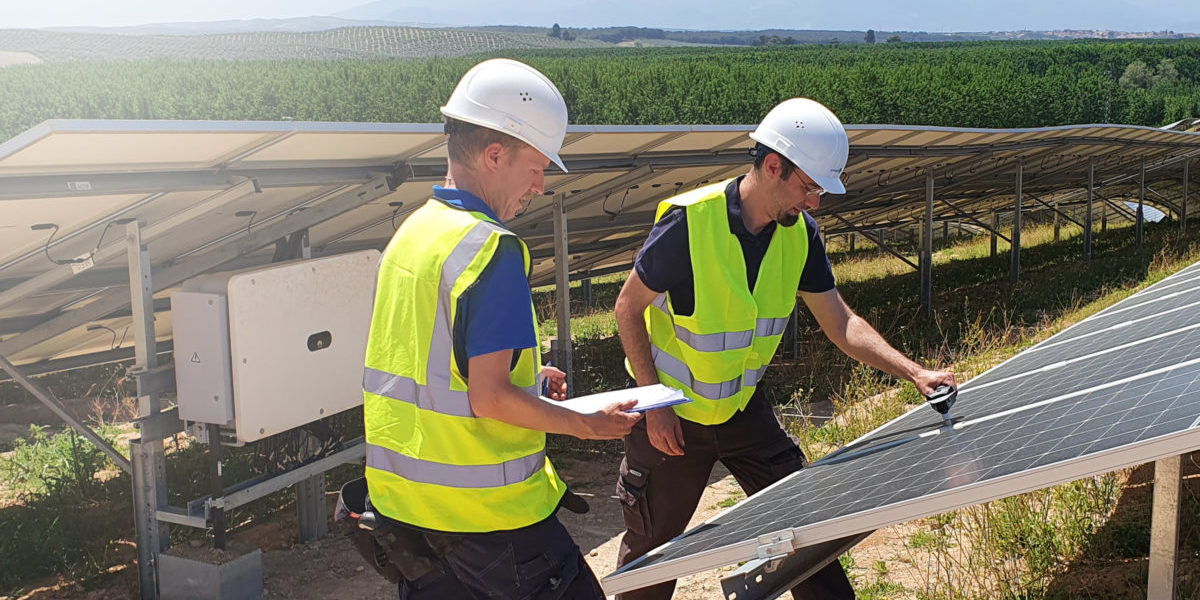From pv magazine global
As heat waves become increasingly frequent, people are starting to ask whether PV systems can cope with such high temperatures.
Extremely hot weather can affect different components of PV systems. Inverters can fail, the efficiency of PV modules can decline, and existing cell damage can become worse. High temperatures also require project owners to clean the modules more frequently.
However, investors, planners, and operators can adjust to heat waves. The key is to follow a number of guidelines to determine the relevance of heat damage in operational PV systems.
Andreas Kern, a technical consultant for meteocontrol GmbH, provided data for this study. Those figures have been coupled with analysis from the meteocontrol monitoring system data pool, which is connected to more than 55,000 PV systems throughout the world.
Inverter failure
If an inverter becomes too hot, it usually switches itself off or reduces its power to such an extent that the higher ambient temperature does not harm it. This is known as temperature derating.
An example from the data pool starts one step before. It considers a specific warning message from certain string inverters, from a pool of 23,000 inverters across Germany, paired with around 1,300 PV systems. This table shows the average number of inverters per day, out of 23,000 inverters, that have reported issues with overheating.

Overheating warnings become more frequent as the average temperature increases. However, it remains uncertain whether this is a statistically significant relationship. In June 2022, the number of overheating warnings was 0.038 % of the inverters connected. But the percentage of actual failures was lower. There could be several reasons for overheating – ventilation faults, poorly ventilated sites, and high ambient temperatures.
The number of possible causes further reduces the percentage of weather-related factors. Analyzing the data pool confirms the empirical value that inverters can generally withstand periods of heat, if the installation site is suitable. Further proof of the heat resistance of inverters is the fact that PV systems operate successfully in southern Europe and even in desert regions. However, overheating reports should nonetheless be taken seriously to ensure that yield is not lost and that the life of the equipment is not shortened.
Does the module efficiency drop significantly during heat waves? A temperature rise of 3 C lowers the efficiency of PV modules by an average of 1%. As a result, the efficiency of the modules is several percent lower during the summer than in wintertime, although solar radiation is times higher in the summer. Accordingly, the losses from reduced efficiency are more than offset by the additional yield. Sunny heat waves are positive on the yield side.
System issues
A suitable installation site for the inverter needs to be found when planning PV projects. Smaller PV systems in the private sector are more likely to have less-considered installation sites. For instance, an inverter fitted to a south-facing wall or a battery storage unit with no shading will inevitably lead to overheating. But planning mistakes can also occur with commercial photovoltaic systems when inverters are mounted on roofs or at the edge of a row of modules without shading, and are thus at least temporarily exposed to direct sunlight.
There needs to be some shading to ensure that the inverter is installed in a cool place and the manufacturer’s requirements and corresponding standards must be implemented. This includes distances from walls and between multiple units. When investing in a PV system, it needs to be checked whether the inverters have been installed in accordance with good professional practice when reviewing the planning documents and, at the latest, during handover by PV experts.
Adequate rear ventilation of the PV modules also must be ensured during the planning phase. Rear ventilation of the modules is very good on open-field systems and with raised-panel roof systems. By contrast, rear ventilation is generally more difficult on flat roof surfaces.
When selecting modules, dust-resistant coatings can also be taken into account, if appropriate modules are available. Theoretically, you could also consider the temperature coefficient when selecting modules. This figure is specified on the module data sheets. In practice, the differences between the temperature coefficients are minimal, as crystalline
Silicon PV modules are almost exclusively installed. In the past, there was greater freedom in terms of module selection when there was significant widespread use of other types of cells, such as cadmium telluride. Given the current material supply bottlenecks, minor adjustment of module parameters is hardly feasible in any case, as customers essentially have to take what is available.
Operational considerations
If an inverter fails due to heat, first check the ventilation on site. For instance, provision will have to be made for shading if an inspection determines that an inverter has no shading.
Power losses due to temperature derating are more difficult to detect if the inverter reduces its power due to the heat. Lower performance is harder to determine by monitoring if the yield is below the target level. Temperature derating can be clearly diagnosed by analysing output characteristics.
Existing damage to the cells of PV modules is exacerbated at high temperatures. Accordingly, preventative measures become more relevant as the temperature increases, as they could prevent shading due to growth on the surface or dirty modules at an early stage. Thermal imaging is able to detect spot shading, hot spots or micro-fractures.
Heat waves are associated with drought. This creates more dust at some sites, which can then accumulate on the modules. Module self-cleaning also decreases with the absence of rain. The need to clean modules could increase in Germany to the current level in Spain. Some 2% to 3% of energy is lost due to dirt, which is why operators clean their modules once or twice a year. In most cases, natural rain is still enough to clean modules in Germany, as only about 1% of the energy is lost.
PV systems can still be operated reliably, even amid heat waves, with careful system planning, proper installation, and professional maintenance. Inspection monitoring processes should include heat-related sources of failure. However, if heat-related failures occur, the cause needs to be quickly identified and rectified to avoid lower yields, as well as technical damage.
Kilian Rüfer is an energy blogger. He covers the energy transition, sustainable finance, and climate communication. He wrote this article on behalf of meteocontrol GmbH.
The views and opinions expressed in this article are the author’s own, and do not necessarily reflect those held by pv magazine.
This content is protected by copyright and may not be reused. If you want to cooperate with us and would like to reuse some of our content, please contact: editors@pv-magazine.com.








By submitting this form you agree to pv magazine using your data for the purposes of publishing your comment.
Your personal data will only be disclosed or otherwise transmitted to third parties for the purposes of spam filtering or if this is necessary for technical maintenance of the website. Any other transfer to third parties will not take place unless this is justified on the basis of applicable data protection regulations or if pv magazine is legally obliged to do so.
You may revoke this consent at any time with effect for the future, in which case your personal data will be deleted immediately. Otherwise, your data will be deleted if pv magazine has processed your request or the purpose of data storage is fulfilled.
Further information on data privacy can be found in our Data Protection Policy.